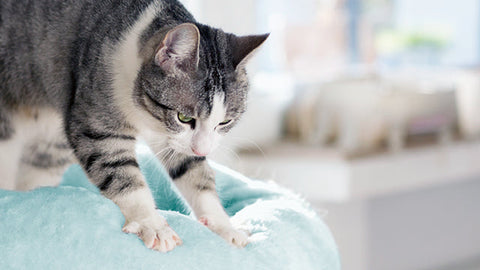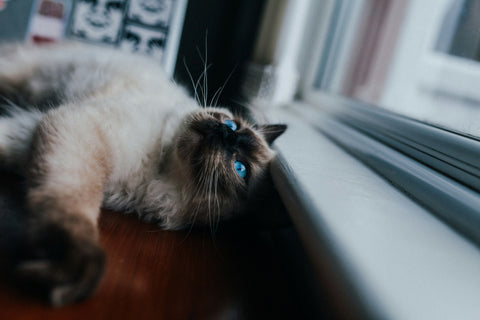Cat kneading refers to the rhythmic motion that cats make with their paws, pressing them alternately into a soft surface like a blanket, pillow, or your lap. It's often accompanied by purring and a relaxed, content demeanor. You may notice your cat "kneading" with both front paws while pushing gently into the surface. This motion can sometimes be mistaken for a kind of "massaging" action, and it’s this motion that has sparked curiosity among cat owners for centuries.
Kneading often starts in kittenhood and can continue throughout a cat’s life. It’s commonly observed in both domestic and wild cats, although the frequency and style of kneading can vary from cat to cat.
The Origins of Kneading in Cats
To understand why cats knead, we must look at its origins. Kneading behavior is thought to be instinctive, originating from a kitten's early days with its mother. When kittens nurse, they knead their mother's belly with their tiny paws to stimulate milk flow. This behavior is essential for them to receive nourishment, and it helps establish a bond between the kitten and the mother.
As cats grow older, this kneading instinct remains intact, though it is no longer associated with feeding. Instead, the kneading action takes on different meanings depending on the cat's environment and emotional state.
Why do Cats Knead?
There are several theories as to why cats knead as adults. Here are the most common reasons:
1. Comfort and Relaxation
For many cats, kneading is a comforting behavior. Cats associate the kneading motion with the safety and security they felt as kittens when nursing from their mother. When a cat kneads, it may be trying to recreate that feeling of comfort and contentment, especially in times of stress or anxiety. If your cat kneads you or a soft object, it’s likely trying to tell you that it feels safe and relaxed in its environment.
2. Marking Territory
Cats have scent glands located in their paws. When a cat kneads, it leaves behind a scent from these glands, marking the object or area as its territory. This territorial marking is often subtle and happens as part of the cat’s natural instinct to establish boundaries. In the wild, this behavior would signal other animals that the area is occupied by a specific cat.
3. Seeking Attention
If your cat kneads you or a soft item when it wants affection, it's likely trying to get your attention. Cats often knead when they want to be petted or held, as the motion is tied to their need for social interaction. Kneading may be a precursor to cuddling or simply an invitation to engage with them.
4. Preparation for Rest
In the wild, cats knead to prepare a resting area. The action of kneading softens and flattens the ground, making it more comfortable for lying down. This instinct is preserved in domestic cats, and even if they have a cozy bed to sleep in, they might knead to "prepare" their space for resting.
5. Pleasure or Contentment
When cats are particularly relaxed or in a state of bliss, kneading can be a sign of pleasure. If your cat is purring while kneading, it’s likely feeling pure joy. This is often seen when a cat is nestled in your lap or lying in a sunspot, feeling content and at ease.
6. Stress Relief
Just as some humans engage in repetitive motions like tapping their foot or biting their nails, cats may knead to relieve stress or anxiety. If your cat is going through a period of change, like moving to a new home or experiencing a disruption in its routine, kneading can serve as a coping mechanism to help calm down.
What Should I Do?
Most of the time, cat kneading is a harmless and even endearing behavior that strengthens the bond between you and your pet. However, if your cat's kneading becomes uncomfortable or problematic, there are ways to manage the behavior:
1. Provide Soft Alternatives
If your cat kneads on you and it's uncomfortable, try offering a soft blanket or cushion as an alternative. Encouraging your cat to knead on a specific object might help avoid the kneading of your skin, especially if your cat has sharp claws.
2. Claw Management
Kneading cats often have sharp claws, and when they knead you, it can result in scratched skin. Keep your cat’s claws trimmed regularly to minimize this. You can also invest in soft claw covers, which are safe and non-invasive and prevent scratching.
3. Redirect Attention
If your cat is kneading excessively on furniture or objects you’d prefer it not to, you can gently redirect the behavior to more appropriate items. Be patient, as this might take time and consistency.
4. Allow the Behavior
Remember, kneading is a natural and comforting behavior. If your cat kneads in your lap or on a blanket, it’s a sign that it feels safe and comfortable. In most cases, it’s best to let the cat indulge in its instincts and enjoy the bonding moment.
Be Sensitive To Your 'Cat's Kneads'!
Cat kneading is an intriguing and endearing behavior that stems from your cat's early life experiences and instinctual needs. Whether your cat kneads for comfort, relaxation, or to mark territory, it’s a sign of affection and trust. By understanding the reasons behind kneading and offering appropriate alternatives when necessary, you can better appreciate this behavior while managing it in a way that works for both you and your feline friend.
If you’re a cat owner, the next time your cat starts kneading on your lap, you can smile knowing that it’s simply engaging in a deeply ingrained behavior that reflects its natural instincts. Embrace the kneading, as it’s a sign of love, security, and the bond you share with your furry companion.




Comments (0)
There are no comments for this article. Be the first one to leave a message!